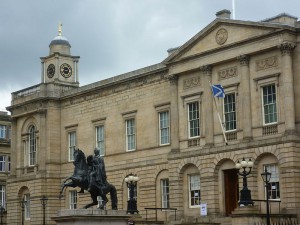
LASER scanners have been used to capture the intricate detail of one of Edinburgh’s most famous landmarks – Robert Adam’s architectural masterpiece General Register House.
The home of National Records of Scotland will be recorded by a team from Historic Scotland and Glasgow School of Art as part of a drive to use technology in our conservation and promotion of Scotland’s heritage.
Cabinet Secretary for Culture Fiona Hyslop said: “We have incredible skills and talents within the heritage sector and using laser scanning to create an enduring record of our historic sites will help us with their conservation and gives us the opportunity to use that information to create virtual models that can add to educational or promotional work.
“It is wonderfully fitting in the Year of Creative Scotland that this iconic building – that will be familiar to so many people and houses so much information about the incredible pasts of so many Scots – is now to become part of a digital archive in its own right.”
The team will produce a detailed 3D survey of the principal apartment, the recently restored rotunda featuring the largest dome designed by Adam.
When combined with the original architectural drawings, building records, contemporary engravings and paint research, the digital data will enable an objective and historically accurate model of General Register House as it would have appeared when the building was completed around 1788, before Robert Reid’s addition of the north range in the 1820s and 30s, and the alterations to the screen wall of c1850 and 1890.
Keeper of the Records and Registrar General George Mackenzie said: “I am delighted to be working with Historic Scotland and Glasgow School of Art to digitally document and model this wonderful building. Innovative when it opened in 1790 it is still being used for its original purpose, which is to house our nation’s archives.”
Doug Pritchard, Head of Visualisation at Glasgow School of Art’s Digital Design Studio, said: “The expertise we have been able to bring together in laser scanning the Scottish and international sites is incredible. We are getting to play a significant part in the histories of world-renowned sites and that is a privilege.”
General Register House, designed and built between 1774 and 1789 by Robert and James Adam, was the first purpose-built public record repository in the British Isles.
Pre-dating both Public Record Office of Ireland (1830s) in Dublin and the Public Record Office (completed 1858) in Chancery Lane, London, it should be seen as a major achievement of the Scottish Enlightenment.
General Register House was arguably the most important public building to be erected in Great Britain between William Kent’s Horse Guards (1751-53) and Sir William Chambers’ Somerset House (1776-96), both in London.
It was also the first public building in Edinburgh’s New Town, occupying a pivotal position at the south end of the North Bridge, which, before the creation of the Mound, formed the principal link between the Old and New Towns.
During the late eighteenth and early nineteenth centuries, royalty and politicians toured Register House when visiting Edinburgh.
It is a tribute to the quality of Robert Adam’s design that almost 225 years later General Register House continues to serve its original purpose.
In 1790, following the completion of the building, James Salisbury, the clerk of works, was instructed to make a detailed wooden model (now lost) of General Register House to record what had been built for maintenance purposes and as a guide to the architect’s proposals for its future extension.
The new digital survey will perform similar functions with the advantages of 21st century technology.

